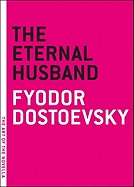The Eternal Husband

Editorial Melville House Publishing
Fecha de edición abril 2005 · Edición nº 1
Idioma inglés
EAN 9780976140733
210 páginas
Libro
encuadernado en tapa blanda
Resumen del libro
The most monstrous monster is the monster with noble feelings.
This remarkably edgy and suspenseful tale shows that, despite being better known for his voluminous and sprawling novels, Fyodor Dostoevsky was a master of the more tightly-focused form of the novella.
"The Eternal Husband" may, in fact, constitute his most classically-shaped composition, with his most devilish plot: a man answers a late-night knock on the door to find himself in a tense and puzzling confrontation with the husband of a former lover--but it isn't clear if the husband knows about the affair. What follows is one of the most beautiful and piercing considerations ever written about the dualities of love: a dazzling psychological duel between the two men over knowledge they may or may not share, bringing them both to a shattering conclusion.
The Art of The Novella Series
Too short to be a novel, too long to be a short story, the novella is generally unrecognized by academics and publishers. Nonetheless, it is a form beloved and practiced by literature's greatest writers. In the Art Of The Novella series, Melville House celebrates this renegade art form and its practitioners with titles that are, in many instances, presented in book form for the first time.
Biografía del autor
x{0026}lt;P x{0026}lt;B Fiódor Mijáilovich Dostoievskix{0026}lt;/B nació en Moscú en 1821, hijo de un médico militar. Estudió en un colegio privado de su ciudad natal y en la Escuela Militar de Ingenieros de San Petersburgo. En 1845, su primera novela, x{0026}lt;I Pobre gentex{0026}lt;/I , fue saludada con entusiasmo por el influyente crítico Bielinski, aunque no así sus siguientes narraciones. En 1849, su participación en un acto literario prohibido le valió la condena de ocho años de trabajos forzados en Siberia, la mitad de los cuales los cumplió sirviendo en el ejército en Semipalatinsk. De regreso a San Petersburgo en 1859 publicó ese mismo año la novela x{0026}lt;I La aldea de Stepanichkov y sus habitantesx{0026}lt;/I . Sus recuerdos de presidio, x{0026}lt;I Memorias de la casa muertax{0026}lt;/I , vieron la luz en forma de libro en 1862. Fundó con su hermano Mijaíl la revista x{0026}lt;I Tiempo x{0026}lt;/I y, posteriormente, x{0026}lt;I Épocax{0026}lt;/I , cuyo fracaso le supuso grandes deudas. La muerte de su hermano y de su esposa el mismo año de 1864, la relación infernal con Apolinaria Suslova, la pasión por el juego, un nuevo matrimonio y la pérdida de su hija le llevaron a una vida nómada y trágica, perseguido por acreedores y sujeto a contratos editoriales desesperados. Sin embargo, desde la publicación en 1866 de x{0026}lt;I Crimen y castigox{0026}lt;/I , su prestigio y su influencia fueron centrales en la literatura rusa, y sus novelas posteriores no hicieron sino incrementarlos: x{0026}lt;I El jugadorx{0026}lt;/I (1867), x{0026}lt;I El idiotax{0026}lt;/I (1868), x{0026}lt;I El eterno maridox{0026}lt;/I (1870), x{0026}lt;I Los endemoniadosx{0026}lt;/I (1872), x{0026}lt;I El adolescentex{0026}lt;/I (1875) y, especialmente, x{0026}lt;I Los hermanos Karamázovx{0026}lt;/I (1879-1880). Sus artículos periodísticos se hallan recogidos en su monumental x{0026}lt;I Diario de un escritorx{0026}lt;/I (1876). Dostoievski murió en San Petersburgo en 1881.x{0026}lt;/P








